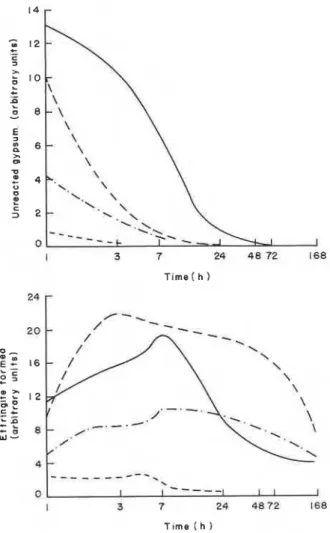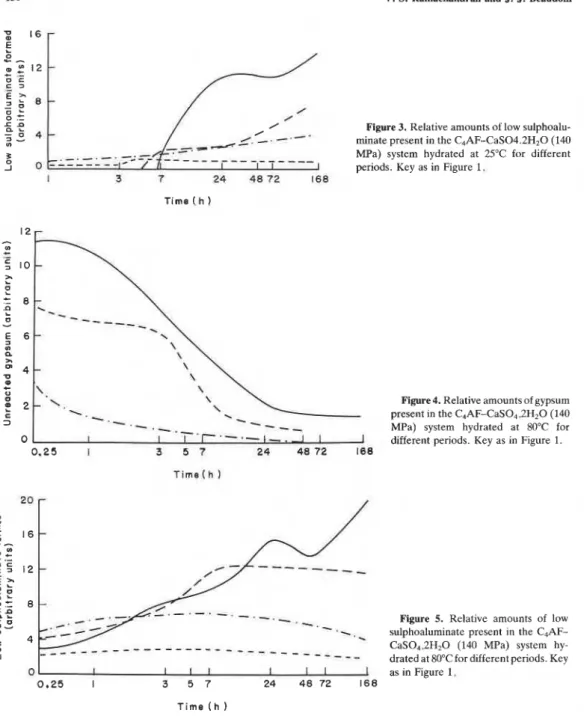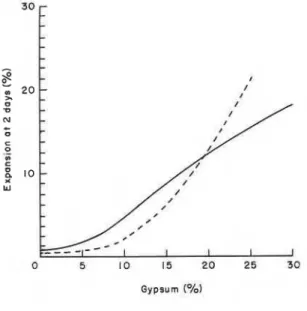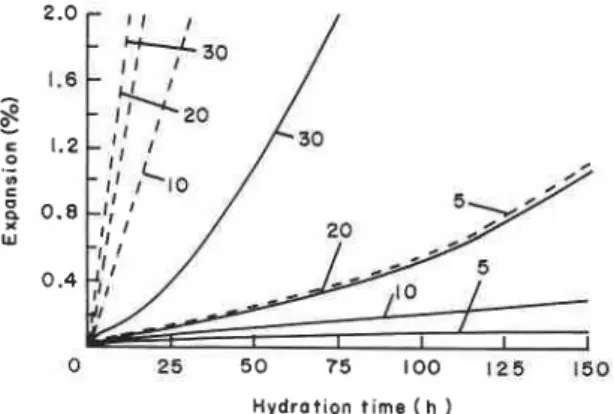Publisher’s version / Version de l'éditeur:
Journal of Chemical Technology and Biotechnology. Chemical Technology, 34A,
4, pp. 154-160, 1984-05
READ THESE TERMS AND CONDITIONS CAREFULLY BEFORE USING THIS WEBSITE.
https://nrc-publications.canada.ca/eng/copyright
Vous avez des questions? Nous pouvons vous aider. Pour communiquer directement avec un auteur, consultez la
première page de la revue dans laquelle son article a été publié afin de trouver ses coordonnées. Si vous n’arrivez pas à les repérer, communiquez avec nous à PublicationsArchive-ArchivesPublications@nrc-cnrc.gc.ca.
Questions? Contact the NRC Publications Archive team at
PublicationsArchive-ArchivesPublications@nrc-cnrc.gc.ca. If you wish to email the authors directly, please see the first page of the publication for their contact information.
NRC Publications Archive
Archives des publications du CNRC
This publication could be one of several versions: author’s original, accepted manuscript or the publisher’s version. / La version de cette publication peut être l’une des suivantes : la version prépublication de l’auteur, la version acceptée du manuscrit ou la version de l’éditeur.
Access and use of this website and the material on it are subject to the Terms and Conditions set forth at
Physico-mechanical characteristics of hydrating tetracalcium
aluminoferrite system at low water solid ratios
Ramachandran, V. S.; Beaudoin, J. J.
https://publications-cnrc.canada.ca/fra/droits
L’accès à ce site Web et l’utilisation de son contenu sont assujettis aux conditions présentées dans le site LISEZ CES CONDITIONS ATTENTIVEMENT AVANT D’UTILISER CE SITE WEB.
NRC Publications Record / Notice d'Archives des publications de CNRC:
https://nrc-publications.canada.ca/eng/view/object/?id=6ed39401-dc97-4920-9699-7fffb361bc83 https://publications-cnrc.canada.ca/fra/voir/objet/?id=6ed39401-dc97-4920-9699-7fffb361bc83
U U A
T I I ~
National
Research
Conseil national
N21d
Council Canada
de
recherche Canada
ns.
1219
c.
2
B r a
!
PHYSICO-MECHANICAL CHARACTERISTICS OF HYDRATING TETRACALCIUM ALUMINOFERRITE SYSTEM AT LOW WATER: SOLID RATIOS
by V.S. Rainachandran and J.J. Beaudoin
ANALYZED
Reprinted from
Journal of Chemical Technology and Biotechnology Volume 34A, No. 4, May 1984
p. 154- 160 q
DBR Paper No. 1219
Division of Building Research
011 a I 1 y d r a t 6 d e l ' a l u m i n o f e r r i t e t e t r a c a l c i q u e ( C 4 A F ) d l a n g 6 5 du g y p s e e n p r o p o r t i o n s d e 0 , 5, 1 0 , 2 0 e t 3 0 p. 100, 5 u n e t e m p e r a t u r e d e 2 5 ou 80°C, s o u s f o r m e d e d i s q u e s ( f o r d s 5 d e s p r e s s i o n s d e 1 4 0 e t 6 9 0 MPa e n v u e d ' o b t e n i r un r a p p o r t e f f i c a c e e a u : s o l i d e d e 0 , 0 8 e t 0 , 1 3 r e s p e c t i v e m e n t ) o u s o u s f o r m e d e p o u d r e ?I d e s r a p p o r t s e a u : c i m e n t d e 0 , s e t 1,O. h a i d e n t i f i e e t 6 v a l u 6 l e s p r o d u i t s d ' h y d r a t a t i o n form& a p r e s d e s p ' e r i o d e s a l l a n t d e q u e l q u e s m i n u t e s 3 s e p t j o u r s . h a a u s s i d e t e r m i n e l a s e q u e n c e d e f o r m a t i o n d e s h y d r a t e s e t l e s v a r i a t i o n s c o r r e s p o r ~ d a n t e s d e l o n g u e ~ ~ r . La f o r m a t i o n d ' u n h y d r a t e h e x a g o n a l , d ' u n h y d r a t e c u b i q u e , d ' e t t r i n g i t e , d e s u l f o - a l u m i n a t e 3 f a i b l e r a p p o r t * e t d e l e u r s p r o d u i r s d ' i n t e r c o n v e r s i o ~ ~ d ' e p e n d a i t p r i n c i p a l e m e n t d e l a t e n e u r e n g y p s e , d e l a t e m p e ' r a t u r e e t du r a p p o r t i n i t i a l e a u : s o l i d e . S e l o n l e s r 6 s u l t a t s d e l ' e t u d e , i l n ' e s t p a s a b s o l u m e n t n e c e s s a i r e q u e l ' e t t r i n g i t e s o i t un p r e ' c u r s e u r l o r s d e l a f o r m a t i o n d e s u l f o - a l u m i n a t e B f a i b l e r a p p o r t 3 / A l o r s q u e l ' h y d r a t a t i o n y- --- -7\ e a u : s o l i d e , 3 \ m i c r o d u r e t i i q j o u r s d'hydra s u l f o - a l u m i n d ' a u t r e s p h a
1
i
J. Chem. Tech. Biotechnol. 1984,34.4,154-160
Physico-mechanical Characteristics of Hydrating Tetracalcium
aluminoferrite System at Low Water
:
Solid Ratios
Vangipuram S. Ramachandran and James J. Beaudoin
Division of Building Research, National Research Council Canada, Ottawa, Canada, KIA OR6 (Manuscriptreceived 29 March 1983 and accepted 14 December 1983)
Tetracalcium aluminoferrite (C4AF) mixed with gypsum in amounts of 0,5,10,20 and 30% was hydrated at 25 or 80°C, either as discs (formed at pressures of 140 and 690 MPa to obtain an effective water: solid ratio of 0.08 and 0.13, respectively) or in powder form at water: cement ratios of 0.5 and 1.0. Hydration products formed at periods ranging from a few minutes to 7 days were identified and estimated. The sequence of hydrate formation and the accompanying length changes were also determined. The formation of hexagonal hydrate, cubic hydrate, ettringite, low sulphoaluminate series and their interconversions was primarily dependent on gypsum content, temperature, and initial water:solid (wls) ratio. The study indicates that ettringite need not necessarily be a precursor of the formation of low sulphoaluminate hydrate when hydration is carried out at a very low wls ratio at 80°C. The microhardness and porosity characteristics of the hydrated products were compared after 2 days of hydration. The relative contribution of low sulphoaluminate, ettringite, and other hydrated phases on strength development were assessed.
Keywords: Tetracalcium aluminoferrite; gypsum: hydration; low sulphoaluminate; ettringite.
1. Introduction
The ferrite phase comprising &12% of an average portland cement, represented by the formula 4CaO.AI2O3.Fe2O3, has received less attention than other cement minerals. This may be ascribed partly to the assumption that the 3Ca0.A1203 and ferrite phases behave in a similar manner. There is evidence, however, that in the presence of gypsum significant differences exist in the behaviour of C3A and C,AF."
Most work on the hydration of portland cement compounds has been carried out at normal wls ratios, but conclusions based on such investigations do not seem to be applicable to those carried out at lower ratios.lP5 A knowledge of the processes and the nature of the products formed at low wls ratios is relevant to the production of superplasticised concrete and high strength or precast concrete. It is the objective of this work to study the significance of lower wls ratios and temperature on the sequential formation of hydration products and strength development in the C~AF-CSH~- H 2 0 system.
2. Experimental
Tetracalcium aluminoferrite used in this investigation had the following chemical analysis: Ca0=45.82%, Fe203=32.65%, AI2o3=20.43%, free Ca0=0.5% and loss on ignition 0.37%. The surface area was 3400 cm2 g-l (Blaine). The particle size of gypsum was less than 75 pm.
Tetracalcium aluminoferrite powder was mixed with 0,5,10,20 or 30% gypsum and was hydrated for up to 7 days at effective wls ratios of 0.08 or 0.13, produced by pressing into discs at a pressure of
Hydration of tetracalcium aluminoferrite 155
140 or 690 MPa. The effective w/s ratios for various C4AF-gypsum mixtures were calculated from the
apparent volume, true density and mass values. These ratios did not vary by more than *7%.
Hydration was carried out at 25 or 80°C.
A differential scanning calorimeter (DSC) supplied as a module to a DuPont 900 thermal analysis system was used to obtain thermograms. X-ray powder photographs (XRD) were obtained with a Philips camera, using a CuKa source. The Aminco-Winslow porosimeter was used to determine porosity and pore size distribution. Length changes were measured by a modified Tuckerman gauge extensometer, and microhardness was determined by a Leitz miniload hardness tester. Details of these methods have been described elsewhere.426
3. Results and discussion
The relative amounts of unreacted gypsum, ettringite and low sulphoaluminate contained in samples with 5, 10, 20 and 30% gypsum and hydrated for different periods are shown in Figures 1-5. The semiquantitative estimation of these compounds was carried out using a DSC by determining the endothermal areas of the peaks caused by dehydration. Gypsum exhibits endothermal effects with peaks in the range 150-200°C, the high sulphoaluminate (ettringite) at about 110- 125°C and the low sulphoaluminate at about 200-210°C. Most samples were also subjected to XRD studies. Although thermal peaks indicated the formation of various products at early times of hydration,
Figure 1. Relative amounts of gypsum present in the C,AF-CaS0,.2H20 (140 MPa) system hydrated at 25°C for different periods. Gypsum (% with respect to C,AF): ---, 5%; -.-.,
10%; --- , 2 0 % ; - ,30%. I I 3 7 24 4 8 72 168
Time ( h )
Figure 2. Relative amounts of ettringite
present in the C4AF-CaS0,.2H20 (140 MPa) system hydrated at 25°C for different periods. Key as in Figure 1.
V. S. Ramachandran and J. J. Beaudoin
Time ( h 1
1 2 r
Figure 3. Relative amounts of low sulphoalu- minate present in the C,AF-CaS04.2H20 (140 MPa) system hydrated at 2S°C for different periods. Key as in Figure 1.
T i m e ( h
Figure 4. Relative amounts of gypsum present in the C,AF-CaS04.2H20 (140 MPa) system hydrated at 80°C for different periods. Key as in Figure 1.
Figure 5. Relative amounts of low sulphoaluminate present in the C4AF- CaS0,.2H20 (140 MPa) system hy- drated at 80°Cfor different periods. Key as in Figure 1.
T i m e ( h )
XRD did not. Either the amounts of hydration products were low or they were not well crystallized for identification by XRD. At later periods of hydration there was a decrease in the intensity of the lines indicating gypsum. Ettringite and low sulphoaluminate phases were detected when larger amounts formed.
Figures 1 and 4 show that in most samples gypsum has reacted almost completely after only 2 days. Its disappearance gives rise to the formation of the ettringite and low sulphoaluminate phases of composition, C3(A,F)3CS.H32 and C 3 ( ~ , ~ ) C S . ~ 1 2 , respectively. All samples formed at 140 MPa and hydrated at 25OC show a general decrease in ettringite after 3-7 h and an increase in the amount
of the low sulphoaluminate phase.
Hydration of tetracalcium aluminoferrite
Figure 6. Microhardness versus porosity for C4AF and C4AF-gypsum systems formed at 140 MPa and hydrated for 2 days at 25 and 80°C.0, C,AF+gypsum, 25°C;
.,
C4AF+gypsum, 80°C. Numbers indicate % gypsum. -,25°C; - - -, 80°C; C4AF (see ref 4).
P o r o s i t y ( O h )
samples hydrated for 2 days at 25OC. Porosity increases as the gypsum contained in the mixture is increased. At 2 days of hydration both low sulphoaluminate and ettringite are present, the sample formed with 30% gypsum consisting mainly of low sulphoaluminate. The increased porosity with higher gypsum contents may be because of the higher expansion occurring as the gypsum content increases (Figure 7). The higher density of the low sulphoaluminate (1.95 g ~ m - ~ ) , in comparison with that of ettringite (1.73-1.79 g cmP3), may also contribute to higher porosity. Under normal conditions of hydration it is generally believed that the conversion of ettringite to low
Figure 7. Expansion of C,AF-gypsum system (w/s=0.13) after 2 days of hydration versus gypsum content.- - -, 25°C; - , 80°C.
158 V. S. Ramachandran and J. J. Beaudoin
sulphoaluminate does not involve and should not, therefore, result in low strengths. At low W/S ratios, owing to the close proximity of the particles, interconversions may lead to expansion.
Comparison in Figure 6 of the curve of the c 4 ~ F + C S H 2 system hydrated at 25°C with that of C4AF shows that at the same porosity the sample without gypsum indicates higher values of microhardness. At 2 days C4AF (0% gypsum) hydrates directly to the cubic and hexagonal phases, exhibiting smaller expansion (Figure 7). A combination of dense structure containing unhydrated C4AF grains bonded to the C4AF hydrated products produces a strong body of low porosity.4 In the C ~ A F + C ~ H ~ - H ~ O system hydrated for 2 days the possible phases present are unhydrated C4AF, the hexagonal phase, C4(A,F)H13, the low sulphoaluminate phase, the high sulphoaluminate, and the hydrous oxides of iron or aluminium of formula (A,F)H3. In this system, in which the initial porosity is low and the particles are in close proximity with each other, it appears that combinations of unhydrated material and hydration products behave as if they are a single component matrix in the porosity range studied. Similar observations have been made for hydrated portland cement containing various hydrated compounds.
Figure 6 also shows that samples made at 80°C exhibit a linear relation similar to that of samples hydrated at 2YC, but the slope of the line is steeper. Lines with different slopes have also been observed for autoclaved portland cement paste and paste hydrated at 20°C. This was ascribed to differences in the density and crystallinity of the hydration products,1 indicating that the property of the matrices is different at the two temperatures. At any porosity c 8 . 5 % the samples formed at 80°C are stronger than those formed at 25OC. Thermal analytical studies indicated that at 5 to 10% gypsum content (68.5% porosity) the samples formed at 80°C have mainly hexagonal and cubic phases. As already indicated, it appears that these phases form a stronger body than the sulphoaluminates. At 20 to 30% gypsum content (>8.5% porosity), however, the samples made at 80°C have lower strengths in spite of the smaller expansion values shown by these samples (Figure 7). At 20 or 30% gypsum content the porosity of the product formed at 25OC is higher than that formed at 80°C. The larger expansion at 25OC may be related to the initial formation of ettringite and its conversion to the low sulphoaluminate. At 80°C, the C4AF seems to convert directly to the low sulphoaluminate phase and at two days there is no ettringite in any of the samples. At 30% gypsum content, although the material formed at 80°C has a lower porosity than that formed at 2YC, the strengths are not significantly different. The formation of lower amounts of hydration products at 80°C may be an important factor responsible for this observation. In addition, because of the high temperature, the rate of formation of hydrates may lead to a steep expansion-time curve, as has been observed at low water: solid ratios (Figure 8). This may result in microcracks, which are not easy to detect.
In view of the above, differences in the strengths of the systems formed at 25 and 80°C cannot be explained solely on the basis of porosity and pore size distribution (Figure 9). Another possibility is that at 80°C the products are better crystallized, having fewer contact areas between the particles than those formed at 25OC. In the C4AF-H20 system, for example, the sample formed at 25°C has a surface area of 10.9 m2 g-l compared with 6.0 m2 g-I for that formed at 80°C. Similar observations have been made in autoclaved cementitious systems.9
Figure 8. Expansion of C4AF-gypsum systems formed at 690 MPa and hydrated at 25 and 80°C. Numbers indicate % gypsum with respect to C4AF). -, 25°C; - - -, 80°C.
0 2 5 5 0 75 100 125 150 Hydration t i m e ( h )
Hydration of tetradcium aluminoferrite
30% 0 20% G 10% 0 5% G z5 por * 38.3% por = 21% por = 5.8% por = 5.5%
-
8
ao0/~ G 20% G 10% G Gpor = 18,096 por ~13.8% por =8.S0/0 por = 3.3%
80°C C
=
2
0 10 1 0.1 0.01 10 1 0.1 0.01 10 1 0.1 0.01 10 1 0.1 0.01 30V0 G 0 or 1O0/0 G por = 33% Unhydrated 10 O 10 1 0.1 0.01 10 1 0.1 0.01Pore diameter (,urn)
Figure 9. Pore size distribution of C4AF-gypsum systems formed at 140 MPa and hydrated for two days at 25 and 80°C (G; %
gypsum with respect to C4AF; POR, porosity).
Mixtures formed at 690 MPa (w/s ratio=0.08) at temperatures of 25 or 80°C show lower expansion than those formed at a w/s ratio of 0.13 (Figure 8) because at any gypsum content these samples showed higher strengths than the corresponding mixtures made at low pressures (140 MPa). Expansions are higher at larger gypsum contents, as observed at a w/s ratio of 0.13. At 25°C the early products are ettringite, and at 2 days small amounts of low sulphoaluminate are formed. At 8WC, however, the product is mainly of the low sulphoaluminate form. At 2 days the microhardness values of the product formed at 25°C are generally higher than those formed at 80°C. Porosity measurements were not carried out for these samples, but it appears that the relations may be similar to those observed for samples made at 140 MPa. Of the systems studied, namely, at w/s ratios of 0.08, 0.13, 0.5 and 1.0, containing 30% gypsum, the sample fabricated at 25°C at 690 MPa had the maximum strength. It contained mainly ettringite.
4. Conclusions
(i) At low W/S ratios C4AF hydration products have greater strength than C4AF+gypsum products.
(ii) Ettringite need not necessarily be a precursor of the formation of low sulphoaluminate hydrate when hydration is carried out at low w/s ratio and high temperature.
(iii) The mechanism of formation of hydration products has to be taken into consideration to explain differences in strength development at different temperatures and similar porosities. (iv) Ettringite in C4AF+CSH2 systems formed at low w/s ratios need not necessarily be
detrimental to strength development.
(v) Low sulphoaluminate formed directly or through conversion of ettringite increases porosity
V. S. Ramachandran and J. J. Beaudoin
Acknowledgements
The experimental support of G. M. Polomark and P. J. Lefebvre is gratefully acknowledged. This paper is a contribution from the Division of Building Research, National Research Council Canada, and is published with the approval of the Director of the Division.
References
1. Ramachandran, V. S.; Feldman, R. F.; Beaudoin, J. J. Concrete Science Heyden & Son Ltd., London, 1981, pp. 427. 2. Ramachandran, V. S.; Feldman, R. F. Cem. Concr. Res. 1973, 3, 729-750.
3. Ramachandran, V. S,; Feldman, R. F. J. App. Chem. Biotechnol. 1973, 23, 625-633. 4. Ramachandran, V. S.; Beaudoin, J. J . J. Mat. Sci. 1976, 11, 1893-1910.
5 . Ramachandran, V. S.; Beaudoin, J. J. 7th International Congress on the Chemistry of Cement, Vol. 11, 1980, pp. 25-30. 6 . Feldman, R . F.; Sereda, P. J.; Ramachandran, V. S. Highway Research Record, 1964, No. 62, 106-118.
7. Mehta, P. K. J. Am. Ceram. Soc. 1969, 52, 521-522,
8. Collepardi, M.; Baldini, G.; Pauri, M.; Corradi, M. Cem. Concr. Res. 1978, 8, 571-580. 9. Beaudoin, J. J.; Feldman, R. F.Cem. Concr. Res. 1975,5, 103-118.
T h i s p a p e r , w h i l e b e i n g d i s t r i b u t e d i n r e p r i n t f o r m by t h e D i v i s i o n of B u i l d i n g R e s e a r c h , remains t h e c o p y r i g h t of t h e o r i g i n a l p u b l i s h e r . I t s h o u l d n o t be r e p r o d u c e d i n whole o r i n p a r t w i t h o u t t h e p e r m i s s i o n of t h e p u b l i s h e r . A l i s t of a l l p u b l i c a t i o n s a v a i l a b l e from t h e D i v i s i o n may be o b t a i n e d by w r i t i n g t o t h e P u b l i c a t i o n s S e c t i o n , D i v i s i o n o f B u i l d i n g R e s e a r c h , N a t i o n a l R e s e a r c h c o u n c i l of C a n a d a , O t t a w a , O n t a r i o , KIA 0R6.




